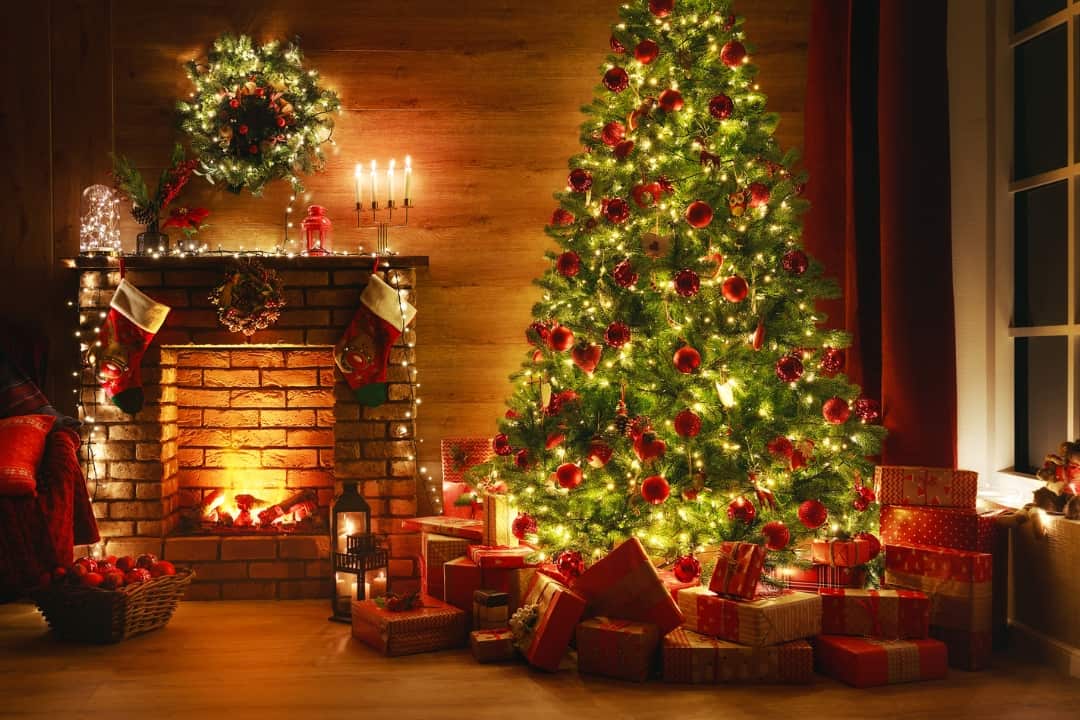As the holiday season approaches, the Christmas colors begin to adorn homes, streets, and shops. And what could be more beautiful and relaxing than seeing these colors and all the emotions they convey around Christmas?
Even though red and green is the traditional combination for the winter holidays, many other colors complement the festive atmosphere of Christmas.
These colors play a significant role in setting the festive mood and have deeper meanings beyond their appearance. If you’ve ever wondered why these are the Christmas colors, the short answer is that they have the most profound symbolic meanings.
In this article, we will explore the Christmas colors and their meanings, shedding light on the emotions they evoke. Moreover, this post will help you create your own Christmas color palettes.
Christmas Colors
1. Red
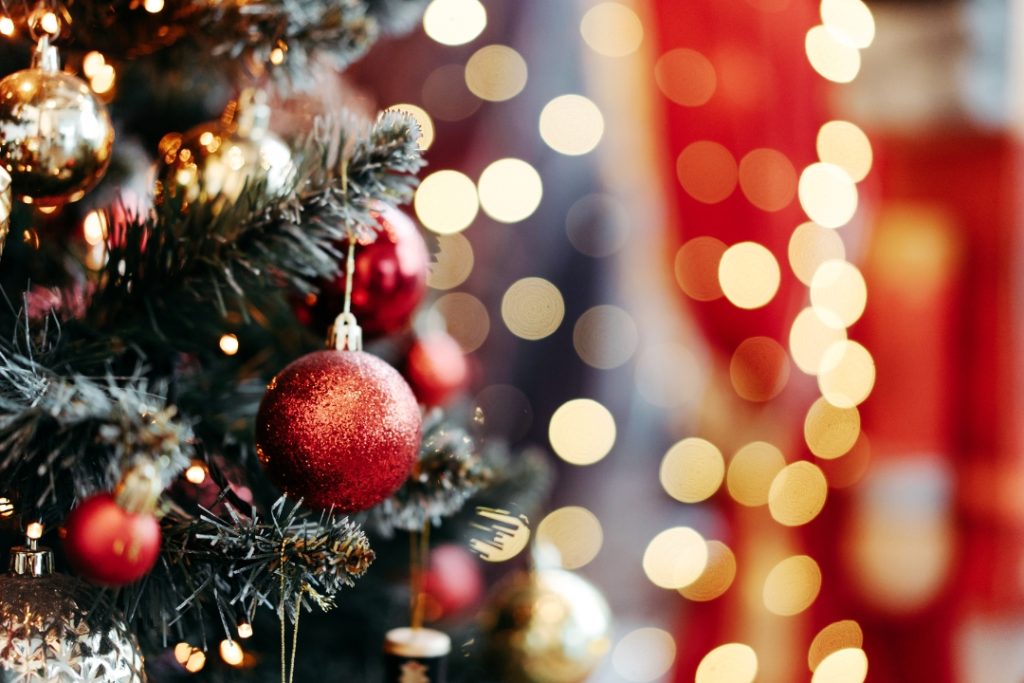
Red is the most popular Christmas color, symbolizing the blood shed by Jesus Christ on the cross. Moreover, it represents love, passion, confidence, courage, and strength.
During the Middle Ages, Christmas plays and pageants were performed, and one popular tradition involved using red apples tied to a Paradise Tree. While the Paradise Tree was a symbol of the Garden of Eden, the red apples were used as ornaments on these trees to represent the fall of Adam when he ate the forbidden fruit.
Red is also the color of Santa’s costume, which was first drawn with a white beard and red suit by the illustrator Thomas Nast.
That’s because New Yorkers, or the non-Dutch community of New York, needed a character similar to Santa Nicholas. The color was inspired by the clothes worn by St. Nicholas, a 3rd-century Catholic bishop known for his charitable work for the poor. There’s no wonder why St. Nicholas symbolizes generosity, joy, and hope.
The iconic red Santa Claus suit, red bows, and red berries are all tied to the spirit of giving and sharing love during this time of year.
The association of red with Santa Claus was also emphasized by illustrators J.C. Leyendecker and Norman Rockwell, who drew a natural character on the cover of the Saturday Evening Post.
In the 1930s, Coca-Cola launched a lovely campaign where Santa Claus appeared in red, enjoying a Coke after the presents had been handed out. These ads resonated so well with the audience that they became a tradition.
2. Green
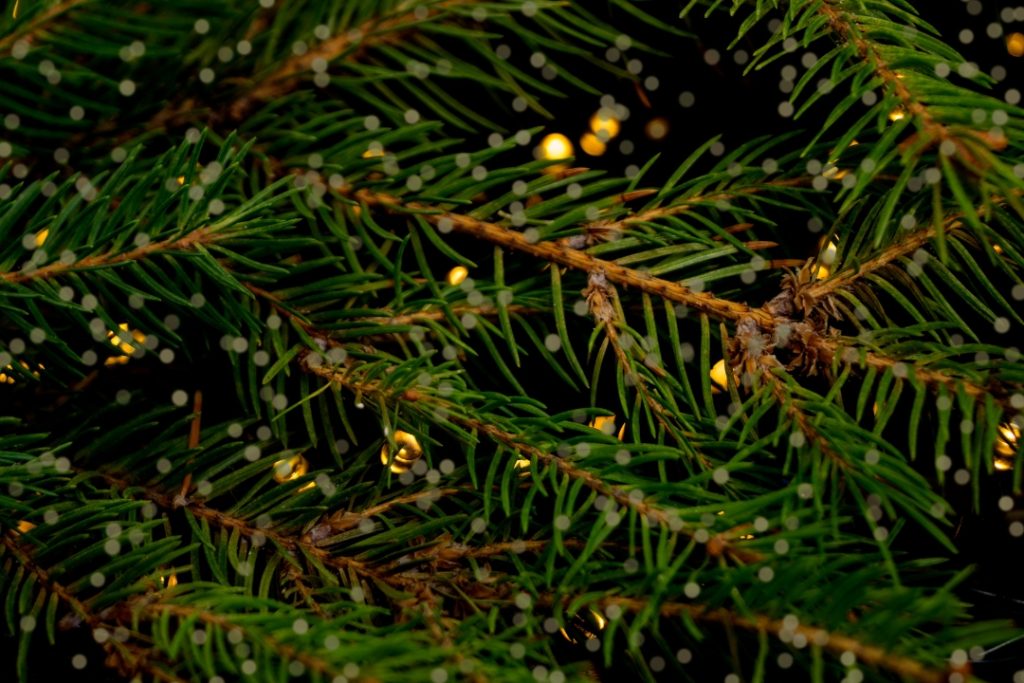
Green, with its lush and vibrant shades, is one of the most traditional Christmas colors, symbolizing renewal, life, and hope. Moreover, this color also symbolizes harmony, balance, health, good luck and prosperity.
This is one of the most traditional Christmas colors, and its origin comes from the ancient Celts, who used holly branches for Christmas decorations. They represent Jesus Christ’s life and eternal nature.
Moreover, the Christmas tree decoration arose from this tradition. The earliest record of decorated trees dates back to Germany in the 1400s.
Green has historically been associated with the anticipation of spring and the end of winter. This transformation is often seen as a symbol of renewal, hope, and the promise of warmer and more prosperous times.
During winter festivities, the ancient Romans and Egyptians used evergreen and palm branches.
For example, Saturnalia was a December festival celebrated in ancient Rome. It was a time for feasting, gift-giving, and merriment.
During Saturnalia, one of the customs was the exchange of evergreen branches, particularly those from laurel and other evergreen trees. These branches were symbols of life and renewal during the darkest days of winter.
Moreover, Egyptians would bring palm branches into their homes and use them as decorations during the winter solstice festival. These branches represented the sun god Ra’s victory over darkness and the promise of longer, sunnier days.
During medieval European Paradise plays, often performed on Christmas Eve, the Paradise Tree used to represent the Garden of Eden typically consisted of a green pine tree adorned with red apples. This tradition of the Paradise Tree evolved into what we now recognize as the modern Christmas tree.
Today, the evergreen trees, wreaths, and mistletoe are all associated with this color, signifying the continuity of life even during the cold winter months.
3. White
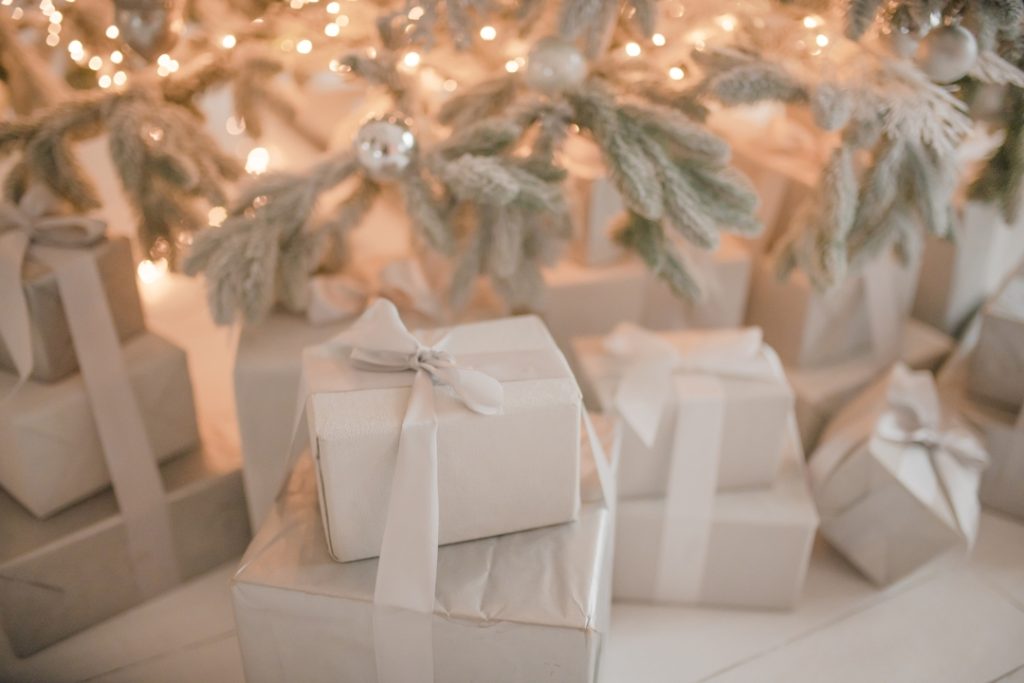
White, often seen as snowflakes gently falling from the sky, brings a sense of purity and tranquility to Christmas. It represents peace, hope, cleanliness, clarity, innocence, and new beginnings.
The association with purity comes from the Virgin Mary – Jesus Christ’s mother – who is often portrayed as wearing white garments.
In Christian iconography and religious art, white serves as a symbol of Mary’s immaculate and pure nature. It signifies her sinlessness, her role as the Mother of Christ, and her divine grace.
Moreover, this color is associated with the idea that Christmas brings a sense of renewal and spiritual purity.
However, white is one of the most beautiful Christmas colors because we inevitably associate it with the snowy landscapes of winter.
Over the years, several singers have portrayed this hue as a cozy color. For example, Bing Crosby’s White Christmas song takes us back to the charm of the winter holidays.
White is also linked to feelings of peace. It’s a tranquil color, reminding people of the peaceful and harmonious feelings that should prevail during the holiday season.
4. Gold
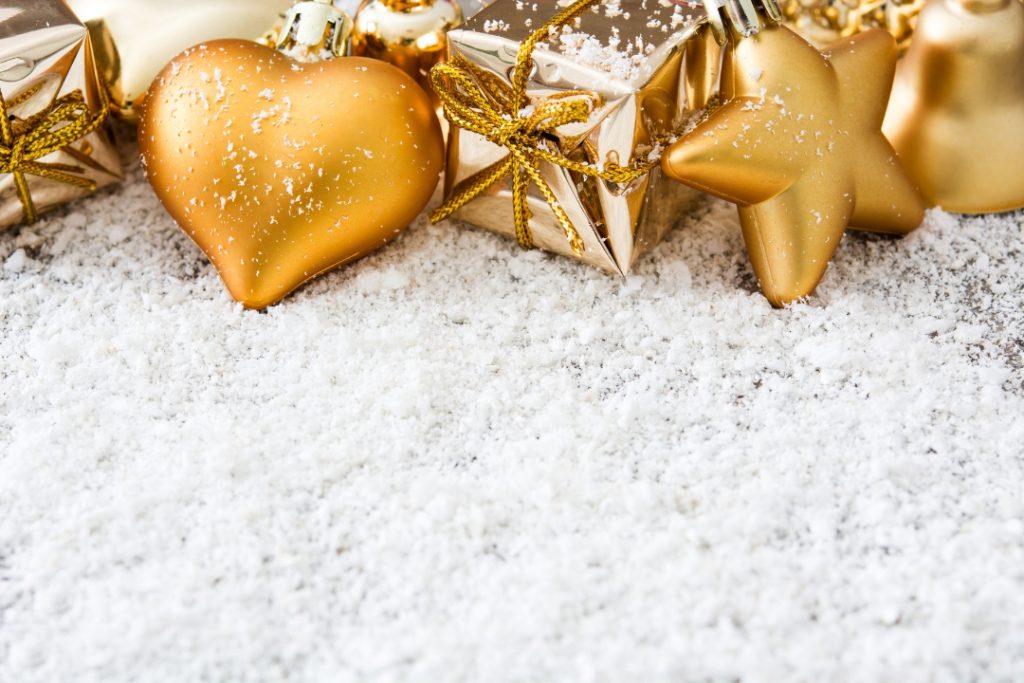
Gold is one of the most beautiful Christmas colors, symbolizing Jesus Christ, the Son of God and our illuminator. It also represents prestige, success, wealth, compassion, and generosity.
Moreover, it reminds us of the precious gifts Jesus received after His birth from the Three Magi (or Wise Men): gold, myrrh, and frankincense.
In biblical times, these gifts were reserved for kings and rulers. The Magi’s presentation of these valuable gifts to the infant Jesus symbolized His divine and kingly nature.
Gold represented His royalty, frankincense, His spirituality, and myrrh foreshadowed His sacrificial role in salvation.
This color also represents wealth, prosperity, and the light that guides us through the darkest nights.
Gold ornaments, tinsel, and twinkling lights all remind us of the treasures we have in our lives and the hope for a brighter future.
5. Blue
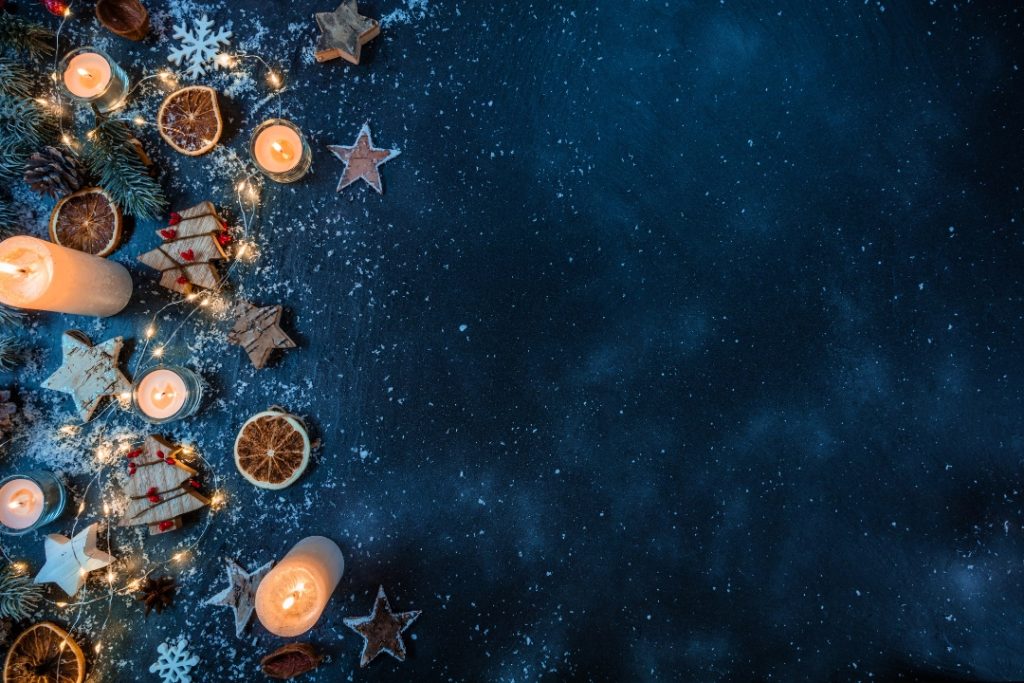
Do you know how blue became a Christmas color? Blue – the color of heaven – has been used in Christian art and decoration to represent the Virgin Mary, the mother of Jesus. Mary is often depicted wearing blue robes in religious paintings and Nativity scenes.
This association with Mary’s blue attire signifies her purity and motherhood, making blue a subtle but meaningful Christmas color.
In medieval times, blue dyes, particularly certain shades of blue derived from specific sources, were highly precious and often more costly than gold. These blue dyes were primarily affordable by the royalty and the wealthy elite.
The most sought-after blue dyes came from rare natural sources, such as the indigo plant and the Tyrian purple snail. Indigo was used to create a deep, vibrant blue, while Tyrian purple produced a royal blue-purple color.
So it’s no wonder why the Virgin Mary was portrayed wearing blue clothes.
Blue also symbolizes trust, loyalty, calmness, honesty, reflection, and the coolness of wintry nights.
Blue ornaments and icicles evoke the chilly beauty of the season, encouraging us to slow down and appreciate the peaceful moments.
6. Purple
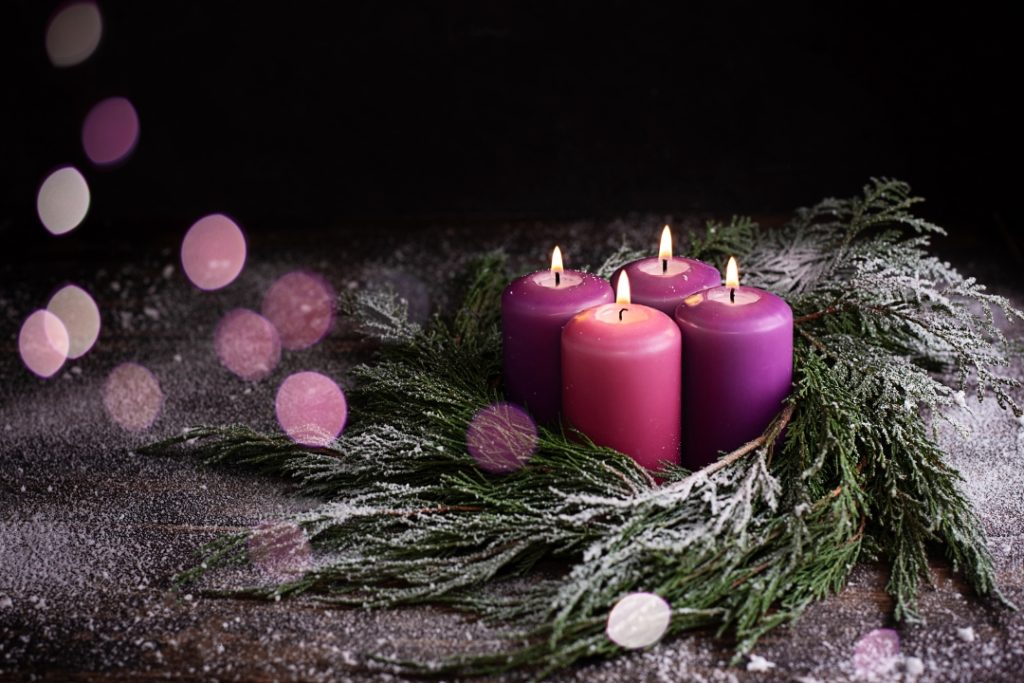
Although not one of the traditional Christmas colors, purple has its roots in Christianity. It is associated with wealth and royalty but can be perceived as a color of spirituality. It also has meanings of mystery, wisdom, imagination, and creativity.
Purple is often used in Advent decorations. It represents the anticipation and preparation for the arrival of Christ. During Advent, the faithful engage in various practices, including fasting and acknowledging their sins, as they prepare their hearts for the celebration of Christ’s birth on Christmas Day.
In many Christian churches, you’ll find purple liturgical vestments, candles, and decorations during Advent, emphasizing this season’s solemn and reflective nature.
As Advent progresses and leads into Christmas, the color scheme often shifts to the celebratory colors of red and white to mark the joyous occasion of Christ’s birth.
However, purple ribbons and candles add a touch of mystique to holiday decorations, reminding us of the magical essence of Christmas.
7. Silver
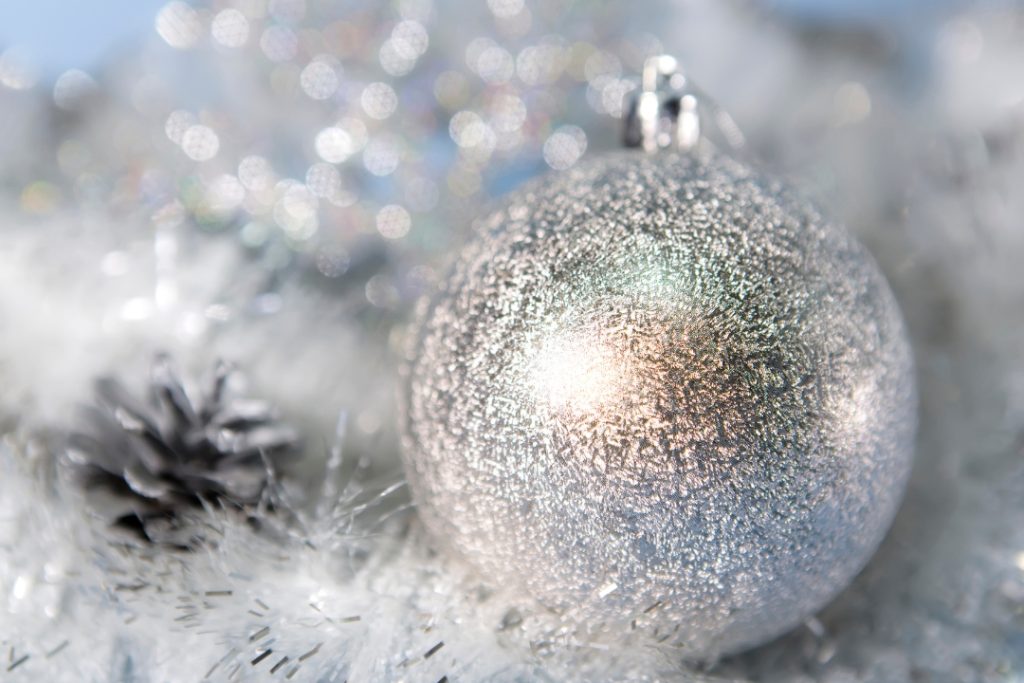
Silver, like the shimmering frost, reflects light and illumination, symbolizing maturity and intelligence as well as calmness and sophistication. It adds a touch of enchantment to Christmas ornaments and tinsel, turning your homes into wonderlands.
Silver has a lengthy trade history in Turkey, dating to around 3000 B.C. However, before 500 B.C., silver was often considered rarer and more precious than gold in the Middle East.
Moreover, it represents the Star of Bethlehem, followed by the Three Magi to find the baby Jesus.
Symbolizing the birth of Jesus Christ, silver is today one of the most popular Christmas colors. It also brings to mind the snowy landscapes.
Often used as an accent color in Christmas decorations, this lovely hue adds a touch of elegance and sparkle to the holiday season.
8. Brown

Brown is an unconventional but increasingly popular choice for Christmas decoration schemes since it’s associated with comfort, nature, stability, and reliability.
In addition, brown represents the simplicity and humility of the manger where the newborn Jesus lay, surrounded by straw and the rustic elements of the stable.
While it may not be one of the traditional holiday hues, it can evoke a cozy and rustic atmosphere reminiscent of a winter cabin retreat. Brown can be used as a grounding neutral backdrop, complementing other festive colors like red, green, or gold.
Moreover, brown represents earthiness and simplicity, which can create a warm and cozy holiday atmosphere.
Many Christmas decorations, such as wooden ornaments, tree stands, and rustic wreaths, feature brown elements.
Traditional vs. Modern Christmas Colors
The classic combination of red and green remains a timeless choice for many. Red signifies love and warmth, while green represents the evergreen trees and life. This combination can be seen in everything from wreaths to stockings.
However, Christmas color trends have expanded to include a wide spectrum in recent years. Pastel shades like blush pink and icy blue offer a fresh take on holiday décor, while metallics like gold and silver add a touch of glamour.
Also, combining earthy tones with green as a Christmas color palette offers a refreshing departure from traditional holiday decor. It infuses a sense of natural beauty into your festive surroundings, evoking the tranquility of a winter forest. For example, you can combine earthy browns with green.
If you prefer a more minimalist look, you can opt for blue, white, and silver. This combination brings elegance and serenity to your holiday decor.
Another idea is to combine red or green with pastels.
Combining pastel tones with red or green in your Christmas color palette creates a delightful fusion of modern aesthetics with traditional holiday charm.
If you prefer a brighter, more clean design, you can opt for white and grey, a cool combo that brings the winter season to life.
Combining neutrals with a traditional color is also a good idea for Christmas colors, as is combining pink, gold, and green.
Last Words on Colors of Christmas
Christmas colors are not only for aesthetic purposes but also carry deep meanings. For example, red symbolizes the love and shed blood of Jesus Christ, while green signifies His eternal nature.
Blue stands for the Virgin Mary, white for purity and snowy landscapes, gold for light, and silver for the Star of Bethlehem, followed by the Three Wise Men.

